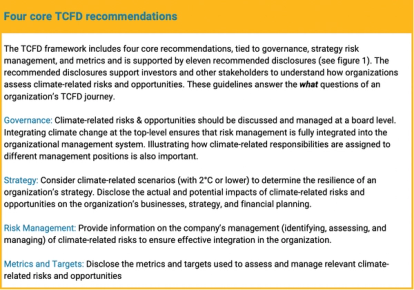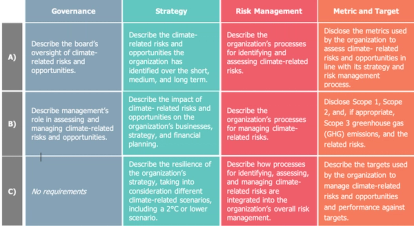
Focus on the power grid – Opportunities and challenges unique to data centre power
by Peter Lo
View post

The most significant risks that organisations face today are related to climate change. The Task Force on Climate-related Financial Disclosures (TCFD) recommendations help organisations to understand and prepare for climate-related risks and capitalise on climate-related opportunities relevant to them. This article elaborates on the most important TCFD requirements, explains how organisations can integrate the recommendations and the downloadable roadmap outlines the 6 phases of the TCFD journey and suggests key activities, outcomes, and tools for each phase.
Today, around 3,400 organisations support TCFD, proving that many organisations have started their TCFD journey. However, knowing where to start and how to go about approaching the four core elements (also referred to as the pillars) supported by the eleven recommended disclosures can be confusing.
With climate change increasingly becoming one of the top three material issues for organisations due to having a felt impact on their business, it is becoming a forefront topic. In S&P Global’s 2021 Corporate Sustainability Assessment (CSA), 23% of surveyed companies included climate change as a material issue, compared to 17% the prior year 1.
Recent developments show that the integration of climate and subsequently TCFD is growing in importance for non-financial reporting which means companies must prepare for mandatory disclosure rules. A survey conducted by S&P Global revealed that a high percentage of companies classified in the carbon-intensive sectors (with greater exposure to transition- and physical- risks) have started integrating TCFD. While 60% of energy firms surveyed are already reporting fully or partially in line with the TCFD’s 11 disclosure recommendations (see figure 1), only 16.5% of companies from the health care industry surveyed integrated TCFD into risk management. These results show an improvement-point in the major gap between different industries.
The fact that TCFD reporting is starting to be compulsory in New Zealand, Japan, and recently in the UK2 (with the G73 agreeing to make TCFD-aligned reporting mandatory) further emphasises this point. With these stronger regulatory requirements, today 3,400 companies in 95 jurisdictions support TCFD. In line with this, several ESG benchmarks have implemented TCFD recommendations into their existing standards. Two well-known benchmarks are the Climate Change Questionnaire (CDP) and the CSA, supporting companies to understand the effects of climate change and identifying flaws in their public disclosure.
Nonetheless, TCFD should not simply be seen as another reporting framework or a box that organisations need to tick - it goes beyond the public reporting on climate risks, it assists in understanding risks and opportunities arising from climate change.


Figure 1: TCFD Recommendations and supporting recommended disclosures
Despite the fact that climate risks differ according to industry and geographical location, the public disclosure requirements and recommendations from TCFD are widely adopted and applicable to organisations across sectors and jurisdictions.
The downloadable roadmap outlines six phases of the TCFD journey. Approaching the process by using the roadmap will help organisations better understand how to include the TCFD recommendations and align and accelerate on TCFD. The 6 phases include:
Although it is estimated that almost 3,400 organisations have embarked on the TCFD journey, the latest Financial Stability Board’s report shows that companies are struggling to adopt the recommended disclosure requirements (see figure 1). For instance, in 2022 only 13% of organisations, disclosed information on the resilience of their strategy (strategy-C). This is a substantial aspect as it reveals how resilient a company’s strategy is to changing climate.
The flip-side of the coin is that best-practice examples show that there are organisations that have already assessed their resilience. The company Lendlease (classified in the materials and building industry) discloses the resilience of its strategy, by outlining the three climate scenarios, Polarisation scenario (>3ºC), Paris Alignment scenario (2–3ºC), and Transformation scenario (<2ºC). For each scenario, Lendlease elaborates on the different climate related-impacts and the residual sensitivity, which is split into development, construction, and investment.
Another example of how to integrate resilience into strategy is Allianz Group. The company outlines two climate scenarios (2ºC and 1.5ºC) and includes different years. Furthermore, the company goes ahead to rank the risks from low to very high and then classifies them into risk enhancers and risk mitigatory categories.
With 37% of organisations disclosing data on Scope 1,2,3 GHG-emissions (metrics and targets-B), it seems that organisations still have some way to go to accelerate their net-zero strategies. Transportations company Maersk serves as a best-practice example, disclosing information according to recommendations for Scope 1,2, and 3 in metrics and targets, category B. Maersk is describing its Scope 1-3 emissions and states the sources of primary emissions from Scope 3. The company committed to net-zero across the business and value chain by 2040 and is aligned with the science-based targets.
At Finch & Beak, our purpose is to accelerate sustainability within the business of our clients. Together with our fellow companies from SLR, we offer a wide range of TCFD support services such as:
If your organisation requires support on its TCFD journey, reach out to Johana Schlotter, at johana@finchandbeak.com or call +31 6 28 02 18 80 to discuss how Finch & Beak can help you.
Photo by Constant Loubier on Unsplash
1S&P Global (2022): More companies calling climate change a 'material issue’ as stress testing gains traction.
2Premium listed companies need to disclose alignment with TCFD for financial year starting January 2021 in a comply and explain basis.
3US, France, Germany, UK and Japan

by Peter Lo

by Melissa Birch, Tarra Tamang

by Mariana Paloscia